Control of Dynamics in Weak PMA Magnets
Abstract
1. Introduction
2. Results and Discussion
2.1. Nanodomain Size
2.2. Static Properties of Stripe Domains
2.3. Dynamics of Stripe Domain Dynamics
2.3.1. Reconfigurability
2.3.2. Nonreciprocity
3. Conclusions
4. Materials and Methods
Funding
Institutional Review Board Statement
Informed Consent Statement
Data Availability Statement
Acknowledgments
Conflicts of Interest
Abbreviations
| 1-D | Uni-Dimensional |
| 3-D | Three-Dimensional |
| AC | Alternating Current |
| CMOS | Complementary Metal-Oxide-Semiconductor |
| DMI | Dzyaloshinksii-Moryia interaction |
| DC | Direct Current |
| FFT | Fourier Fast Transform |
| FMR | Ferromagnetic Resonance |
| GPU | Graphical Processing Unit |
| GHz | Gigahertz |
| IMA | In-plane Magnetic Anisotropy |
| PMA | Out-of-plane Magnetic Anisotropy |
| tc | Critical Thickness |
References
- Iwasaki, S. Perpendicular magnetic recording-Its development and recent realization. J. Magn. Magn. Mater. 2012, 324, 244–247. [Google Scholar] [CrossRef]
- Vavaro, G.; Laureti, S.; Fiorani, D. L10 FePt-based thin films for future perpendicular magnetic recording media. J. Magn. Magn. Mater. 2014, 368, 415–420. [Google Scholar] [CrossRef]
- Spezzani, C.; Fortuna, F.; Delaunay, R.; Popescu, H.; Sacchi, M. X-Ray holographic imaging of magnetic order in patterned Co/Pd multilayers. Phys. Rev. B 2013, 88, 224420. [Google Scholar] [CrossRef]
- Miguel, J.; Peters, J.F.; Toulemonde, O.M.; Dhesi, S.S.; Brookes, N.B.; Goedkoop, J.B. X-Ray resonant magnetic scattering study of magnetic stripe domains in a-GdFe thin films. Phys. Rev. B 2006, 74, 094437. [Google Scholar] [CrossRef]
- Voltan, S.; Cirillo, C.; Snijder, H.J.; Lahabi, K.; García-Santiago, A.; Hernandez, J.M.; Atanasio, C.; Aarts, J. Emergence of the stripe domains in patterned permalloy films. Phys. Rev. B 2016, 99, 094406. [Google Scholar] [CrossRef]
- Zhang, Y.; Wang, S.-S.; Li, F.; Jiang, W.; Zhang, Z.-L.; Chen, Z.-Y. Thickness and temperature dependent out-of-plane anisotropy of amorphous CoSiB thin films. Phys. Stat. Sol. (B) Basic Solid State Phys. 2018, 255, 1800041. [Google Scholar] [CrossRef]
- Acher, O.; Boscher, C.; Brulé, B.; Perrin, G.; Vukadinovic, N.; Suran, G.; Joisten, H. Microwave permeability of ferromagnetic thin films with stripe domain structure. J. Appl. Phys. 1997, 81, 4057–4059. [Google Scholar] [CrossRef]
- Song, N.; Lv, B.; Meng, J.; Gong, Z.; Zhang, X.; Zhang, Q. Tunable high-frequency properties of flexible FeGa films with rotatable stripe domain. J. Magn. Magn. Mater. 2020, 519, 167510. [Google Scholar] [CrossRef]
- Bisero, D.; Fin, S.; Ranchal, R. Rotation of stripe domains in a sputter deposited Tb-Fe-Ga thin film. Thin Solid Films 2017, 628, 158–162. [Google Scholar] [CrossRef]
- Tacchi, S.; Silvani, R.; Carlotti, G.; Marangolo, M.; Eddrief, M.; Rettori, A.; Pinni, M.G. Strongly hybridized dipole-exchange spin waves in thin Fe-N ferromagnetic films. Phys. Rev. B 2019, 100, 104406. [Google Scholar] [CrossRef]
- Ebels, U.; Buda, L.; Ounadjela, K.; Wigen, P. Ferromagnetic resonance excitation of two-dimensional wall structure in magnetic stripe domains. Phys. Rev. B 2001, 63, 174437. [Google Scholar] [CrossRef]
- Hierro-Rodríguez, A.; Cid, R.; Vélez, M.; Rodríguez-Rodríguez, G.; Martín, J.I.; Álvarez-Prado, L.M.; Alameda, J.M. Topological defects and misfit strain in magnetic stripe domains of lateral multilayers with perpendicular magnetic anisotropy. Phys. Rev. Lett. 2012, 109, 117202. [Google Scholar] [CrossRef]
- Álvarez-Prado, L.-M.; Pérez, G.T.; Morales, R.; Salas, F.; Alameda, J.M. Perpendicular anisotropy detected by transversely biased initial susceptibility via the magneto-optic Kerr effect in FexSi1-x and FExSi1-x/Si multilayers: Theory and experiment. Phys. Rev. B 1996, 56, 3306–3317. [Google Scholar] [CrossRef]
- Álvarez-Prado, L.M.; Alameda, J.M. Micromagnetism of nanowires with low out-of-plane anisotropy. Phys. B Condens. Matter. 2004, 343, 241–246. [Google Scholar] [CrossRef]
- Voltairas, P.A.; Fotiadis, D.I.; Massalas, C.V. Estimation of exchange constant A and g factor for CoxNi1-x microspheres from size-dependent ferromagnetic resonance modes. J. Magn. Magn. Mater. 2000, 217, L1–L4. [Google Scholar] [CrossRef]
- Cao, D.; Cheng, X.; Pan, L.; Zhu, Z.; Feng, H.; Wang, Z.; Wang, J.; Liu, Q.; Han, G. Estimating the in.-plane anisotropy and saturation magnetization of magnetic films. IEEE Trans. Mag. 2017, 52, 2000706. [Google Scholar] [CrossRef]
- Papp, A.; Csaba, G.; Dey, H.; Madami, M.; Porod, W.; Carlotti, G. Wavegiudes as sources of short-wavelength spin waves for low-energy ICT applications. Eur. Phys. J. B 2018, 91, 107. [Google Scholar] [CrossRef]
- Salansky, N.M.; Khrustalev, B.P. Peculiarities of the resonance absorption in the magnetic films magnetized to non-saturated state. Czech. J. Phys. 1971, 21, 419–428. [Google Scholar] [CrossRef]
- Trautvetter, C.-U. Spin-Wave spectra below saturation magnetization and at various orientations. Phys. Stat. Sol. (B) Basic Solid State Phys. 1974, 65, 671–676. [Google Scholar] [CrossRef]
- Lee, S.J.; Tsai, C.C.; Cho, H.; Seo, M.; Eom, T.; Nam, W.; Lee, Y.P.; Ketterson, J.B. Hysteretic characteristics of low-field microwave absorption of a Co thin film. J. Appl. Phys. 2009, 106, 063922. [Google Scholar] [CrossRef]
- García-Sanchez, F.; Borys, P.; Soucaille, R.; Adam, J.-P.; Stamps, R.L.; Kim, J.-V. Narrow Magnomic waveguides based on domain walls. Phys. Rev. Lett. 2015, 114, 247206. [Google Scholar] [CrossRef] [PubMed]
- Wang, L.; Gao, L.; Jin, L.; Liai, Y.; Wen, T.; Tang, X.; Zheng, W.; Zhong, Z. Magnonic a waveguide based on exchange-spring magnetic structure. AIP Adv. 2018, 8, 055103. [Google Scholar] [CrossRef]
- Grassi, M.; Geilen, M.; Louis, D.; Morteza, M.; Brächer, T.; Hehn, M.; Stoeffler, D.; Bailleul, M.; Pirro, P.; Henry, Y. Slow-Wave-Based Nanomagnonic Diode. Phys. Rev. Appl. 2020, 14, 024044. [Google Scholar] [CrossRef]
- Park, H.-K.; Lee, J.-H.; Yang, J.; Kim, S.-K. Interaction of spin waves propagating along narrow domain walls with a magnetic vortex in a thin-film-nanostrip cross-structure. J. Appl. Phys. 2020, 127, 183906. [Google Scholar] [CrossRef]
- Chang, L.-J.; Chen, J.; Qu, D.; Tsai, L.-Z.; Liu, Y.-F.; Kao, M.-Y.; Liang, J.-Z.; Wu, T.-S.; Chuang, T.-M.; Yu, H.; et al. Spin wave injection and propagation in a magnetic nanochannel from a vortex core. Nanoletters 2020, 20, 3140–3146. [Google Scholar] [CrossRef]
- Haldar, A.; Kumar, D.; Adayeye, O.A. A reconfigurable waveguide for energy-efficient transmission and local manipulation of information in a nanomagnetic device. Nat. Nanotech. 2016, 11, 437–443. [Google Scholar] [CrossRef]
- Wang, Q.; Pirro, P.; Verba, R.; Slavin, A.; Hillebrands, B.; Chumak, A.V. Reconfigurable nanoscale spin-wave directional coupler. Sci. Adv. 2018, e1701517. [Google Scholar] [CrossRef]
- Manipatruni, S.; Nikonov, D.E.; Young, I.A. Beyond CMOS computing with spin and polarization. Nat. Phys. 2018, 14, 338–343. [Google Scholar] [CrossRef]
- Lehrer, S.S. Rotatable Anisotropy in negative magnetostriction Ni-Fe films. J. Appl. Phys. 1963, 34, 1207–1209. [Google Scholar] [CrossRef]
- Murayama, Y. Micromagnetics on stripe domain films. I. Critical cases. J. Phys. Soc. Jpn. 1966, 21, 2253–2266. [Google Scholar] [CrossRef]
- Gajdek, M.; Wasilewski, W. The description of the domain structure in thin ferromagnetic films with thickness near the critical value. J. Magn. Magn. Mater. 1983, 37, 246–252. [Google Scholar] [CrossRef]
- Pant, B.B.; Matsuyama, K. Numerical investigation of stripe structures in ferromagnetic thin films with perpendicular anisotropy. Jpn. J. Appl. Phys. 1993, 32, 3817–3822. [Google Scholar] [CrossRef]
- Marty, A.; Samson, Y.; Belakhovsky, M.; Dudzik, E.; Dürr, H.; Dhesi, S.S.; Van der Laan, G.; Goedkoop, J.B. Weak-stripe magnetic domain evolution with an in-plane field in epitaxial thin flms: Model versus experimental results. J. Appl. Phys. 2000, 87, 5472–5474. [Google Scholar] [CrossRef]
- Sukstanskii, A.L.; Primak, K.I. Domain structure in an ultrathin ferromagnetic film. J. Magn. Magn. Mater. 1997, 169, 31–38. [Google Scholar] [CrossRef]
- Leliaert, J.; Dvornik, M.; Mulkers, J.; De Clercq, J.; Milošević, M.V.; Van Waeyenberge, W. Fast micromagnetic simulations on GPU-recent advances made with mumax3. J. Phys D Appl. Phys. 2018, 51, 123002. [Google Scholar] [CrossRef]
- Markó, D.; Valdés-Bango, F.; Quirós, C.; Hierro-Rodríguez, A.; Vélez, M.; Martín, J.I.; Alameda, J.M.; Schmool, D.S.; Álvarez-Prado, L.M. Tunable ferromagnetic resonance in coupled trilayers with crossed in-plane and perpendicular magnetic anisotropy. Appl. Phys. Lett. 2019, 115, 082401. [Google Scholar] [CrossRef]
- Gruszecki, P.; Banerjee, C.; Mruczkiewicz, M.; Hellwing, O.; Barman, A.; Krawczyk, M. The influence of the internal domain wall structure on spin wave band structure in periodic magnetic domain patterns. Sol. Stat. Phys. 2019, 70, 79–312. [Google Scholar]
- Muview2 by Graham Rowlands. Available online: https://grahahamrow.github.io/Mumax2/ (accessed on 9 December 2020).
- Camara, I.S.; Tacchi, S.; Garnier, L.-C.; Eddrief, M.; Fortuna, F.; Carlotti, C.; Marangolo, M. Magnetization dynamics of weak stripe domains in Fe-N thin films: A multi-technique complementary approach. J. Phys. C Condens. Matter. 2017, 29, 465803. [Google Scholar] [CrossRef] [PubMed]
- Sekiguchi, K.; Yamada, K.; Seo, S.M.; Lee, K.J.; Chiba, D.; Kobayashi, K.; Ono, T. Nonreciprocal emission of spin-wave packet in NiFe film. Appl. Phys. Lett. 2010, 97, 022508. [Google Scholar] [CrossRef]
- Träger, N.; Gruszeki, P.; Lisieki, F.; Groß, F.; Förster, J.; Weigand, M.; Głowiński, H.; Kuświk, P.; Dubowik, J.; Shütz, G.; et al. Real space observation of magnon interaction with driven space-time crystals. Phys. Rev. Lett. 2021, 126, 057201. [Google Scholar] [CrossRef]
- Gladii, O.; Haidar, M.; Henry, Y.; Kostylev, M.P.; Bailleul, M. Frequency nonreciprocity of surface spin wave in permalloy thin films. Phys. Rev. B 2016, 93, 054430. [Google Scholar] [CrossRef]
- Schneider, T.; Serga, A.A.; Neumann, T.; Hillebrands, B.; Kostylev, M.P. Phase reciprocity of spin-wave excitation by a microstrip antenna. Phys. Rev. B 2008, 77, 214411. [Google Scholar] [CrossRef]
- Gallardo, R.A.; Alvarado-Seguel, P.; Schneider, T.; Gonzalez-Fuentes, C.; Roldán-Molina, A.; Lenz, K.; Lindler, J.; Landeros, P. Spin-wave non-reciprocity in magnetization-graded ferromagnetic films. New J. Phys. 2019, 21, 033026. [Google Scholar] [CrossRef]
- Wang, Y.; Xing, Z.; Qiao, Y.; Jiang, H.; Yu, X.; Ye, F.; Li, Y.; Wang, L.; Liu, B. Asymmetric atomic diffusion and phase growth at the Al/Ni and Ni/Al interfaces in the Al-Ni multilayers obtained by magnetron deposition. J. Alloys Comp. 2019, 789, 887–893. [Google Scholar] [CrossRef]
- Gas, P.; Bergman, C.; Lábár, J.L.; Barna, P.B.; d’Heurle, F.M. Formation of embedded Co nanoparticles by reaction in Al/Co multilayers and impact on phase sequence. Appl. Phys. Lett. 2008, 84, 2421. [Google Scholar] [CrossRef]
- Talapatra, A.; Adayeye, O.A. Linear chains of nanomagnets: Engineering the effective magnetic anisotropy. Nanoscale 2020, 12, 20933–20944. [Google Scholar] [CrossRef]
- Sud, A.; Zollitsch, C.W.; Kaminaki, A.; Dion, T.; Kahn, S.; Iihama, S.; Mikazumi, S.; Kurebayashi, H. Tunable magnon-magnon coupling mediated by dynamic dipolar interaction in synthetic antiferromagnets. Phys. Rev. B 2020, 102, 017203. [Google Scholar] [CrossRef]
- Funada, S.; Nishimura, T.; Shiota, Y.; Kasukawa, S.; Ishibashi, M.; Moriyama, T.; Ono, T. Spin-wave propagation in ferrimagnetic GdxCo1-x. Jpn. J. Appl. Phys. 2019, 58, 080909. [Google Scholar] [CrossRef]
- Yoshimine, Y.; Tanaka, Y.Y.; Shimura, T.; Satoh, T. Unidirectional control of optically induced spin waves. Eur. Phys. Lett. 2017, 117, 67001–67004. [Google Scholar] [CrossRef]
- López-Flores, V.; Mawass, M.-A.; Herrero-Albillos, J.; Uenal, A.-A.; Valencia, S.; Kronast, F.; Boeglin, C. A local view of the laser induced magnetization domain dynamics in CoPd stripe domains at the picosecond time scale. J. Phys. C 2020, 32, 465801. [Google Scholar]
- Che, P.; Baumraertl, K.; Kúlolóvá, A.; Dubd, C.; Grundler, D. Efficient conversion od exchange magnons below 100 nm by magnetic coplanar waveguides. Nat. Commun. 2020, 11, 1145. [Google Scholar] [CrossRef] [PubMed]
- Verba, R.; Carpentieri, M.; Finocchio, G.; Tiberkevich, V.; Slavin, A. Excitation of propagating spin waves in ferromagnetic nanowires my microwave voltage-controlled magnetic anisotropy. Sci. Rep. 2016, 6, 25018. [Google Scholar] [CrossRef] [PubMed]
- Rana, B.; Otani, Y. Towards magnonic devices based on voltage-controlled anisotropy. Comm. Phys. 2019, 2, 90. [Google Scholar] [CrossRef]
- Tang, M.; Zhao, B.; Zhu, W.; Zhu, Z.; Jin, Q.Y.; Zhang, Z. Controllable interfacial effects on the magnetic dynamic properties of perpendicular [Co/Ni]5/Cu/TbCo composite thin films. ACS Appl. Mater. Interf. 2018, 10, 5090–5098. [Google Scholar] [CrossRef]
- Venkat, G.; Fanghor, H.; Prabhakar, A. Absorbing boundary layers for spin wave micromagnetics. J. Magn. Magn. Mater. 2018, 450, 34–39. [Google Scholar] [CrossRef]
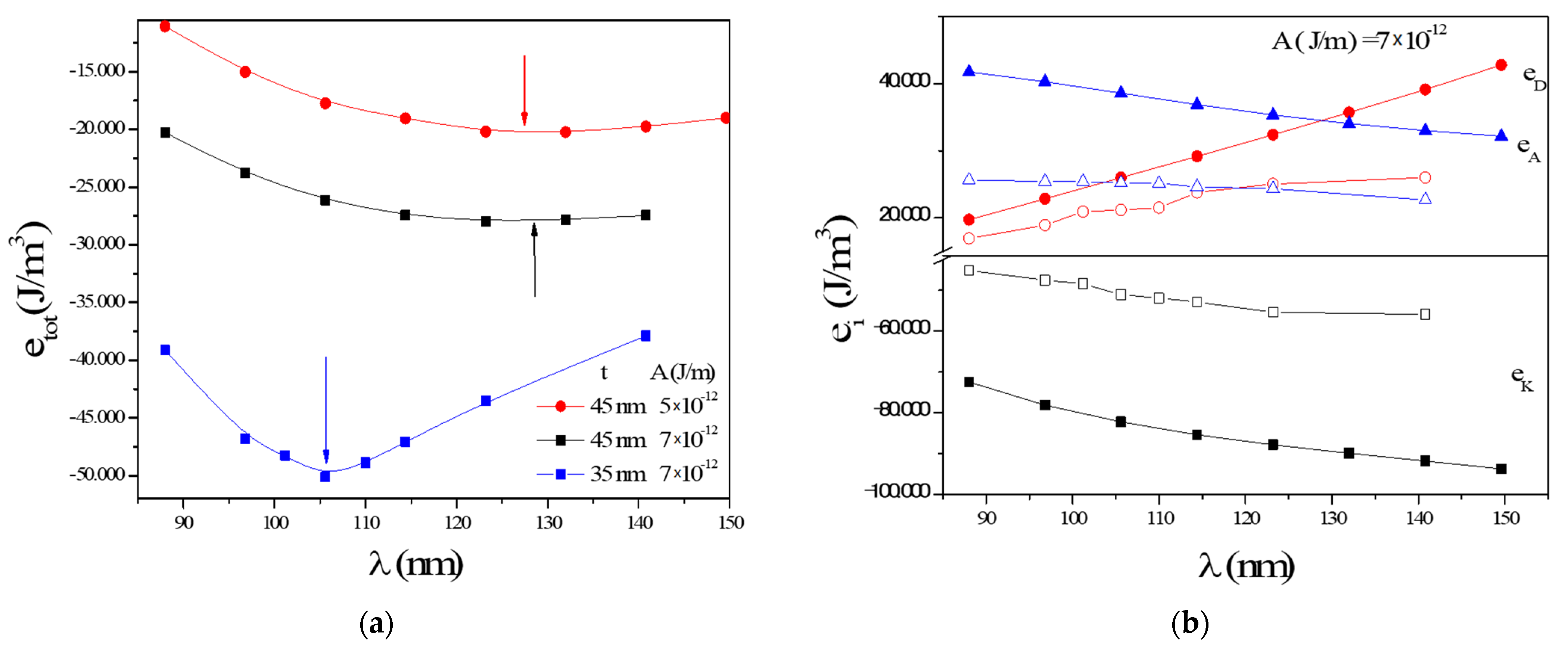

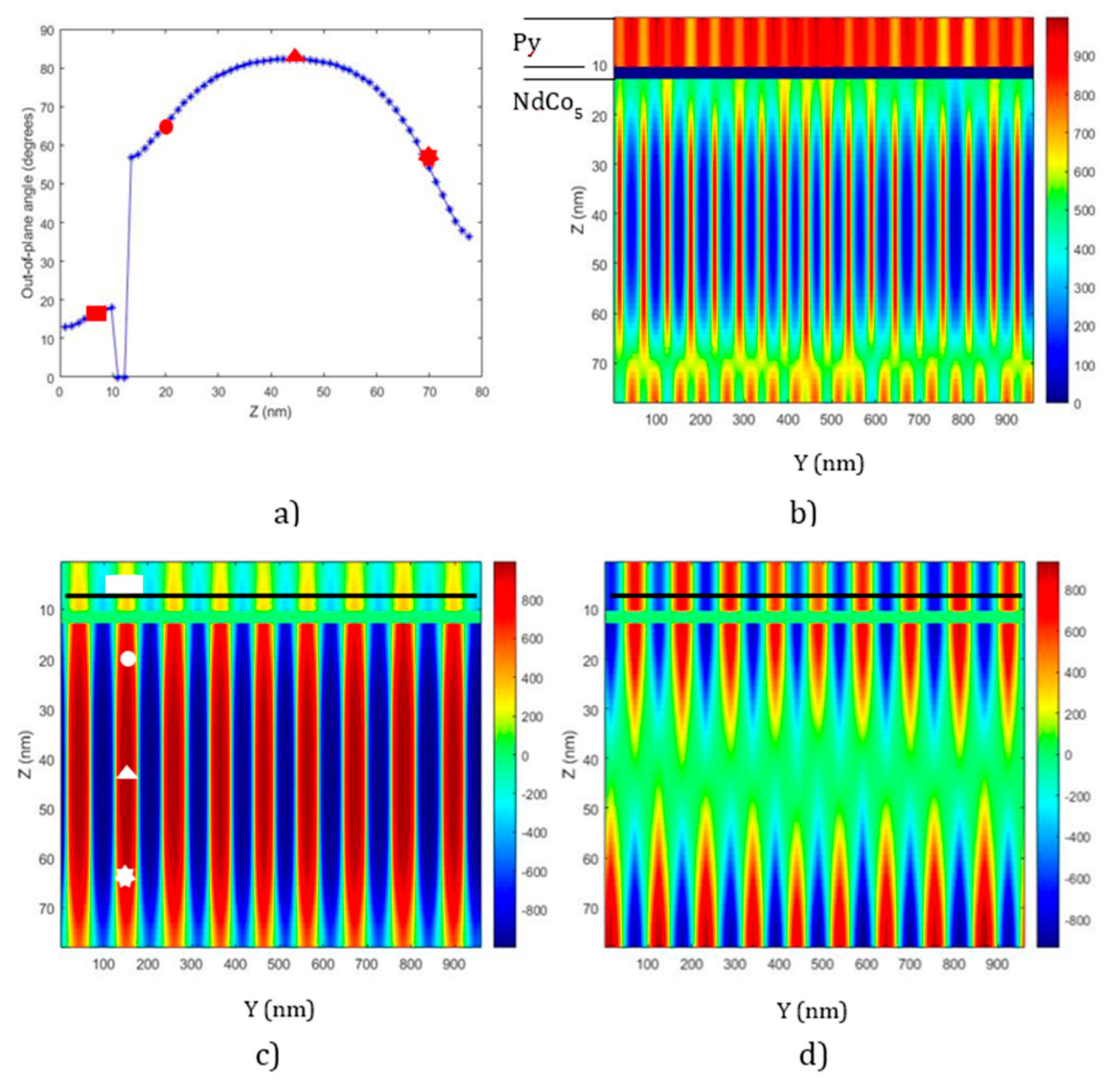


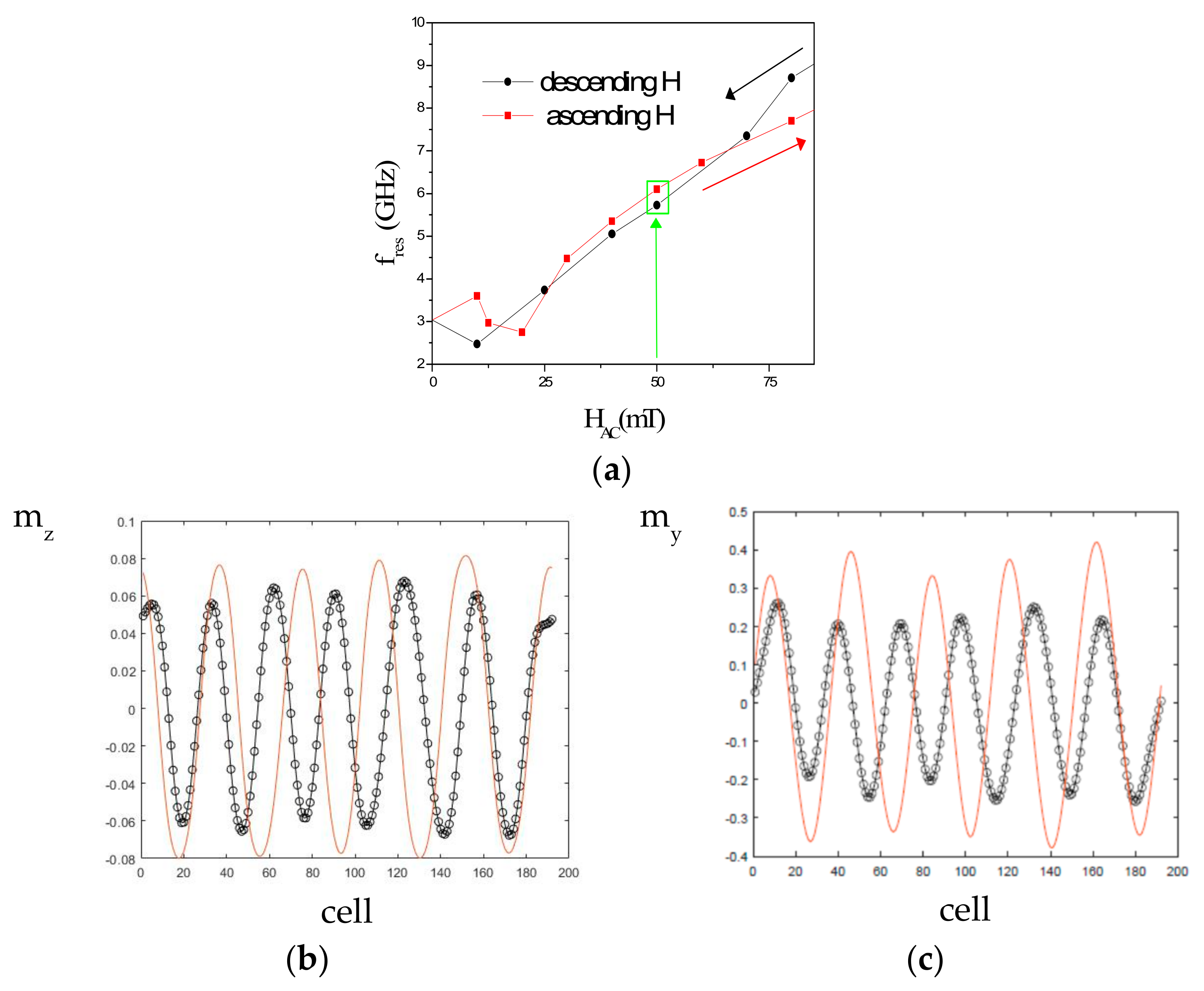
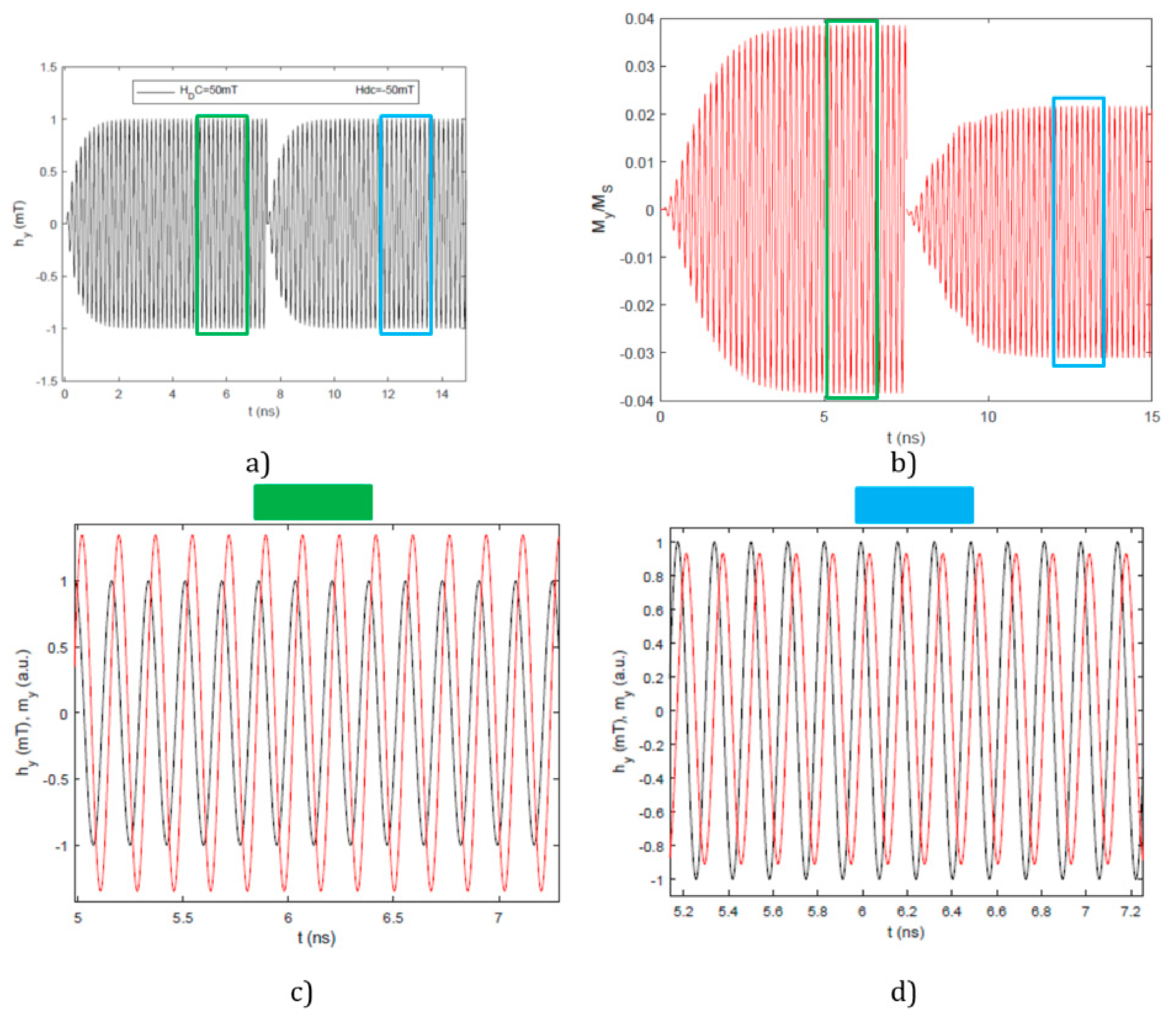
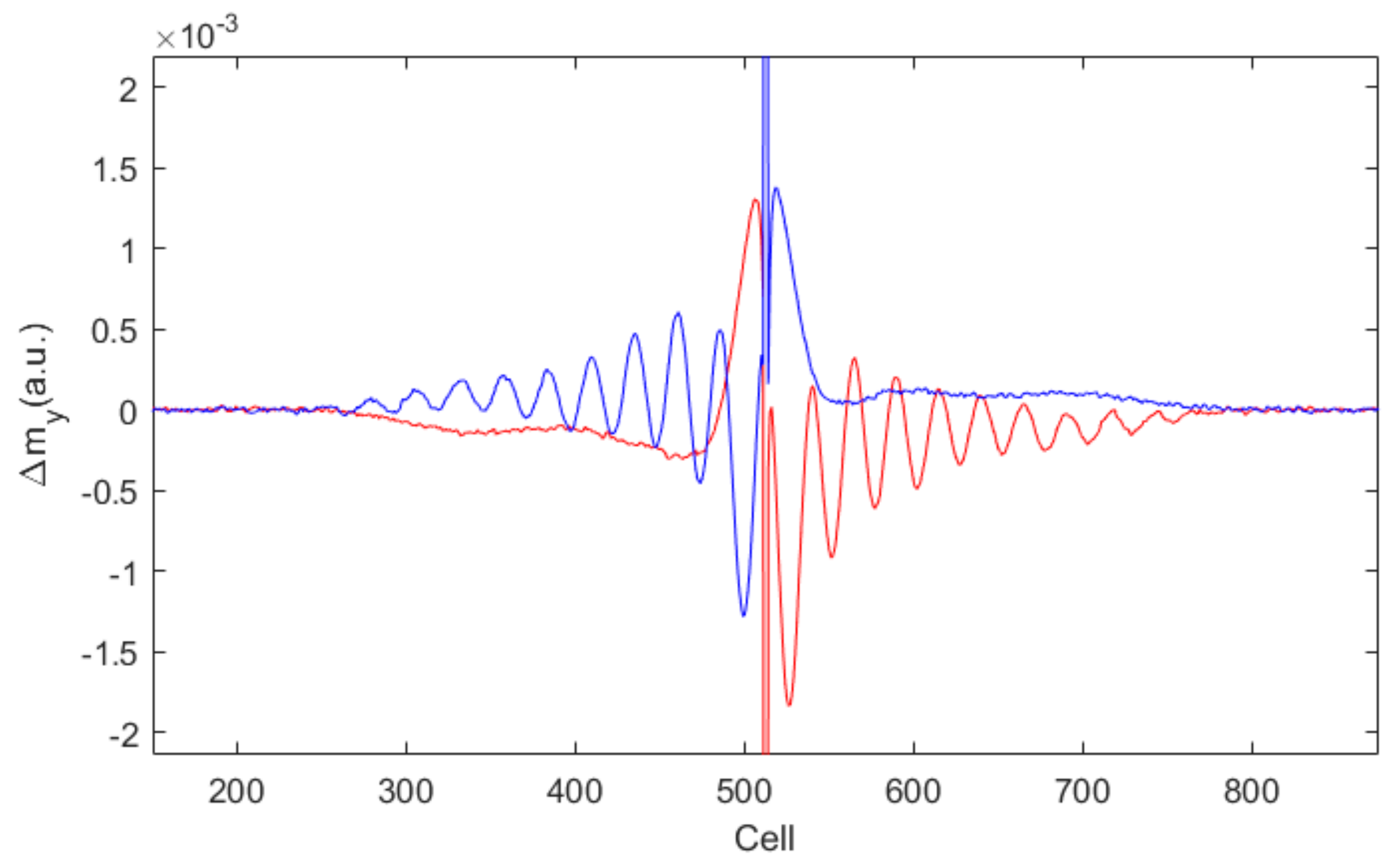
Publisher’s Note: MDPI stays neutral with regard to jurisdictional claims in published maps and institutional affiliations. |
© 2021 by the author. Licensee MDPI, Basel, Switzerland. This article is an open access article distributed under the terms and conditions of the Creative Commons Attribution (CC BY) license (http://creativecommons.org/licenses/by/4.0/).
Share and Cite
Álvarez-Prado, L.M. Control of Dynamics in Weak PMA Magnets. Magnetochemistry 2021, 7, 43. https://doi.org/10.3390/magnetochemistry7030043
Álvarez-Prado LM. Control of Dynamics in Weak PMA Magnets. Magnetochemistry. 2021; 7(3):43. https://doi.org/10.3390/magnetochemistry7030043
Chicago/Turabian StyleÁlvarez-Prado, Luis M. 2021. "Control of Dynamics in Weak PMA Magnets" Magnetochemistry 7, no. 3: 43. https://doi.org/10.3390/magnetochemistry7030043
APA StyleÁlvarez-Prado, L. M. (2021). Control of Dynamics in Weak PMA Magnets. Magnetochemistry, 7(3), 43. https://doi.org/10.3390/magnetochemistry7030043





